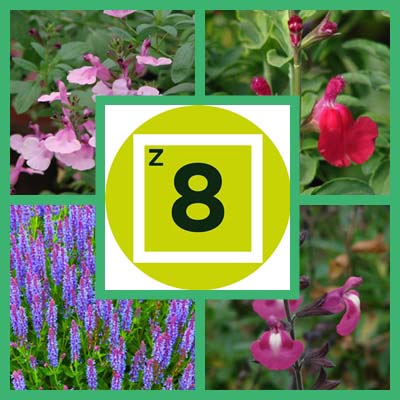Getting Started: Salvias for Zone 8

USDA Plant Hardiness Zone 8 swings in a deep, broad arc from the West Coast to the Gulf Coast and back up the East Coast to the northeast edge of Virginia. What all its diverse areas have in common climatically is an average low winter temperature of 10 degrees F.
In botany, hardiness most often refers to the ability of a plant's roots to survive winter cold for re-emergence the following growing season. USDA zones only consider average minimum winter temperatures. The USDA divides all of America into 13 winter climate zones, each of which is divided into two subzones.
Finding Zone 8
The interactive USDA Plant Hardiness Zone Map uses two shades of gold to indicate zones 8a and 8b. At Flowers by the Sea, we don't use these subzones, because many factors affect a sage's success -- such as microclimates and beneficial placement in a yard. Some of these factors may be more important than a half-zone difference in temperature. For an overall explanation of USDA zones, please read Getting Started: USDA Plant Hardiness Zones.
Of course, local growing conditions, including moisture, have a major impact on what you can grow.
Zone 8 begins at about Bellingham, Washington, where annual rainfall averages 37 inches annually. It travels southward to part of the Mohave Desert in the southern tip of Nevada where the small town of Beatty receives roughly 6 inches of moisture annually.
Moisture increases dramatically as Zone 8 moves on to Austin, Texas and then up to Little Rock, Arkansas, which averages about 50 inches of rain a year. The zone continues across to Tallahassee, Florida, where the average is about 59 inches. It turns north to Norfolk, Virginia, where the statistic falls to 47 inches. So there are many parts of Zone 8 where rainfall is heavy.
Selecting Zone 8 Salvias
Each of the 1000-some sages in the Salvia genus has its own range of hardiness zones. However, one thing that almost all sages have in common is the need for well-drained soil to avoid root rot. That's especially important in areas with heavy rainfall.
Finding water-loving Salvias is easy on the FBTS website due to the Salvias by Culture category in our catalog menu atop our homepage. Its button leads to links such as "Moisture Loving," which opens a queue of Salvias that do well in damp conditions. Remember that excellent soil drainage is a key to success.
European Meadow Sages are water lovers that do well in woodland and cottage gardens. Plants such as Wand Sage (S. virgata) and Austrian Sage (Salvia austriaca) likely will thrive in a sunny to shady garden in Bellingham or Norfolk, but may not have much of a chance in southern Nevada. Instead, drought-resistant sages -- such as those in the Autumn Sage and Mountain Sage group (S. greggii and S. Microphylla) -- are good choices for parts of Zone 8 with dry climates.
Water-loving choices that can handle Tallahassee's abundant rainfall and Florida heat, in general, include Costa Rica Blue Sage (S. x guaranitica 'Costa Rica Blue') and Gravid Sage (S. gravida).
So, Salvias that come back year after year in a Zone 8 garden vary depending on local conditions. Aside from winter chill, rainfall and well-drained soil, you have to take into account sun exposure, summer heat, soil fertility and frost.
Considering all the cultivation factors necessary for a successful flowering landscape can be overwhelming, especially if you are a new gardener. However, another FBTS online catalog tool is our Salvia Finder, which provides filters for sorting plants based on your preferences and growing conditions.
Listening to Your Concerns
Whether it rains every third day or only three times a year where you live, FBTS has a wide range of Salvias for varying conditions. We know what grows where. Please call or email us to discuss your concerns about selecting the right plants for your Zone 8 landscape.

 Salvia VIBE® 'Ignition White'
Salvia VIBE® 'Ignition White'  Salvia VIBE® 'Ignition Purple'
Salvia VIBE® 'Ignition Purple'  Salvia greggii 'Elk Pomegranate'
Salvia greggii 'Elk Pomegranate'  Salvia microphylla 'Hot Lips'
Salvia microphylla 'Hot Lips'  Salvia x guaranitica 'Costa Rica Blue'
Salvia x guaranitica 'Costa Rica Blue'  Salvia gravida
Salvia gravida  Salvia nemorosa 'Burgundy Candles'
Salvia nemorosa 'Burgundy Candles'
Comments
There are no comments yet.